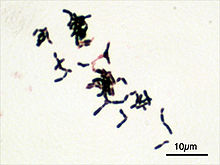The non-pathogenic bacteria usually don’t cause any harm to the body.
The non-pathogenic bacteria generally present on or inner parts of the body of humans or animals but they don’t cause any harm and beneficial to the health.
Non Pathogenic Bacteria Examples:
Staphylococcus epidermis:
Staphylococcus epidermis is an anaerobic gram positive rod shaped bacteria. This is also coagulase negative bacteria. This grows in grape like structures by pairing and also grows in single cells. It is commonly found on the surface of the skin so this is referred as common flora of humans.
This is also found rarely on the mucosal flora as well as marine sponge. By nature this is not harmful but if it enters the blood stream it can cause infections like intravascular epidermis in the humans.
Bifidobacteria:
Bifidobacteria is an anaerobic, gram positive, non-motile bacteria. This can grow in rods as well as in clusters. This is commonly found in both intestinal parts of humans and animals.
This bacterial species have the ability to digest monosaccharaides, disaccharides and plan polysaccharides like pectin, galacto-saccharide and frucoligosaccharides. This is most commonly used in food technology to produce fermented milk in large scale.
It can also be used in the production of probiotics. This bacterial species like B.infantis, B.breve and B.longum can synthesise the vitamins like riboflavin, biotin, folic acid, thiamine, pyridoxine, cobalamine as well as ascorbic acid. This class of bacteria have several health benefits in humans.
They can aid the digestion of lactose, colonizing of intestinal tract, prevention of acute diarrhea and antibiotic related diarrhea. It can also boost the intestinal immunity, reduce serum cholesterol levels and hypertension, suppression of cancer too.

Lactobacillus:
Lactobacillus is a microaerophilic, gram positive, non-spore forming, rod shaped bacteria. This is normally present in several body pars of humans mainly in intestinal parts and vaginal parts of women.
This most commonly used as fermenter in the production of food products like yoghurt, cheese, wine, beer, cocca and pickles. There are 7 types of lactobacilli species basing on the presence of 16S RNA. They are namely Lb.buchneri, Lb.planarum, Lb.casei, Lb.salivarius, Lb.reueri, Lb.sakei, Lb.delbrukii.
The lactobacilli species paly a pivotal role in the digestion of the lactose, citrate and lactate. Some times these species may be infectious in humans, commonly cause urinary tract infections.
Escherichia Coli:
E.coli is an anaerobic, gram negative, rod shaped –coli from bacteria. It is commonly present in the intestine of humans and animals. Usually promotes the intestinal health and helps in the prevention of diarrhea. It usually non pathogenic and may cause infections like urinary tract infections sometimes.
Read More On: Do Bacteria Have Lysosomes: Why, How and Detailed Insights.
Bacteriods:
Bacteriods are an obligative anaerobic, gram negative bacteria. They can be motile and non- motile depending on their species. There are more than 3o species of bacteriods are present. These are considered to be normal flora in the large intestine of humans. They can aid the fermentation of indigestible polysaccharides.
Brevibacterium linens:
Brevibacterium linens is a gram positive, aerobic, non-motile, rod shaped bacterial species. It generally considered to be normal flora of humans.
These species are used in the food technology in the production of several types of cheese as they has the ability of producing different aromas. They can also produce the enzymes like peptidases, lipases and proteinases.
Frequently Asked Questions:
Name the food items which contain Bifidobacterium?
The food items like apple, yoghurt, whole grains, berries, onion and chicory have the good amount of bifido bacterium that can act as a probiotic. Probiotics usually help in the prevention of diarrhea.
What is Actinomycosis?
Actinomycosis means that heamotogenous anaerobic infection which is caused by Actinomycetes species. The symptoms include sinuse, tuberculosis.
What are the non pathogenic gut bacteria?
The single celled intestinal protozoa which present in intestinal parts without causing any infections are called nonpathogenic gut bacteria.
Do non pathogenic bacteria cause infections?
The non pathogenic bacteria like E. coli and staphylococcus epidermis cause infections if they enter into the blood stream.
What is the importance of non pathogenic bacteria?
The non pathogenic bacteria generally help in the digestion of food products like lactose, polysaccharides and can produce several vitamins and also enzymes. They can also guard our intestine by acting as probiotics.
Also Read:
- Trophic level
- Hand anatomy
- Do eukaryotes have introns
- Domain bacteria examples
- Is vitamin a coenzyme
- Kingdom fungi examples
- Do plant cells have lysosomes
- Animal chromosomes structure
- Examples of extremophiles
- Cell without cytoplasm

Hi…I am Nagasrilakshmi Narne, a postgraduate in Biotechnology and English. also completed my B.Ed. I worked in Vimtalabs as a project trainee and I have work experience as a faculty of English. So I can explain topics in simple language.
Let’s connect through LinkedIn